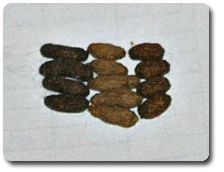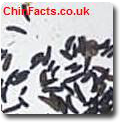 Plentiful droppings is a very good sign that the digestive system is working correctly. Healthy faeces from a chinchilla should be solid, dry and pellet shaped. They should be numerous in quantity and look brownish in colour. It is almost as if the pellets come out again looking almost the same a how they went in. Plentiful droppings is a very good sign that the digestive system is working correctly. Healthy faeces from a chinchilla should be solid, dry and pellet shaped. They should be numerous in quantity and look brownish in colour. It is almost as if the pellets come out again looking almost the same a how they went in.
The droppings should be odourless and not have pieces missing, be watery or sticky or have holes in them. Any of these things could suggest a problem or illness with your chinchilla.
The colour of a healthy chins poo will depend a lot on its usual diet - the only time to become alarmed is when the size, shape or colour changes for your chin when its diet has remained the same.
Chinchillas do however actually produce two types of dropping the same as rabbits do, one is for disguarding waste and a second type is for eating and reprocessing the nutrients. These are often eaten as they are produced and are not dropped to the floor.
This dropping-eating (called coprophragy) is essential for their health - and it allows them to balance their intestinal bacteria/flora in order to breakdown their foods and is also their main source of B vitamins - which are produced internally in the caecum!!
Signs of a too many treats or digestive upsets may be:
Soft, mucous, slimy, additional fluid, green, joined together in chains
Signs of constipation may be:
Small, hard, very dark, curved, thin droppings (see below)

Signs of dental problems may be:
Small hard droppings due to the chin with dental problems eating less fibre to continue normal gut function, or droppings that contain unchewed hay when broken open.
|

